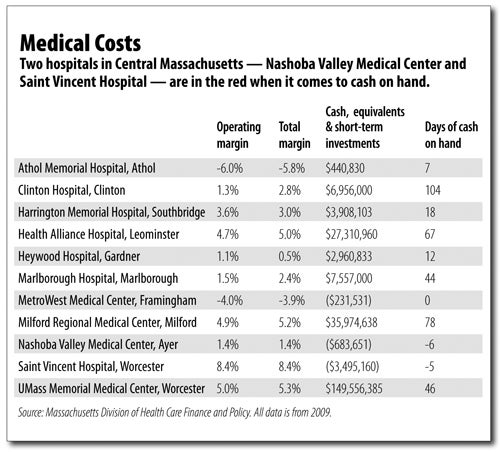The rise of health care costs is one of the most fraught issues up for discussion on Beacon Hill each year. So when the state’s Division of Health Care Finance and Policy issued a report earlier this year pointing out that the hospital systems in the state had net assets of more than $17 billion in 2008, the Massachusetts Hospital Association fired back.
In a report of its own, the MHA argued that the $17 billion number is virtually meaningless, and that upon analysis, the DHCFP numbers really show that the state’s hospitals are low on funds.
Among the hospitals under scrutiny in the DHCFP report is UMass Memorial Medical Center in Worcester, which, in 2009, had an operating margin of almost 5 percent and nearly $150 million in cash and short-term investments.
Information Gathering
DHCFP Commissioner David Morales said the intent of the division’s report, which was requested by the state legislature, was to unearth data, not make value judgments. Morales said it’s interesting to see that the state’s hospital systems have $33 billion in total assets, but “whether or not that’s appropriate, that’s a whole different question.” The issue needs more study, he said.
Still, the legislature has been debating policy changes that pull the numbers in the report out of the realm of the academic. In May, the Senate passed a health cost control bill that would assess the richest hospitals a total of $100 million as a one-time fee to curb increases, though the House seems unlikely to follow suit. Many policymakers also hope to pass more comprehensive legislation on health costs as soon as possible.
One thing both the DHCFP and the MHA can agree on is that not every hospital has a significant stockpile of assets — in fact, some are clearly hurting quite badly.
The MHA response points out that, of the 66 hospitals considered in the report, 45 had less than 30 days of cash on hand at the end of fiscal 2008, and 12 had a week or less. It also quoted the report in saying that 13 hospitals had too little income to cover payments on their existing debt.
“Some hospitals are experiencing real financial challenges while others are definitely not experiencing those challenges — they’re doing very well,” Morales said.
It’s those hospitals that the DHCFP says are doing very well that are the real subject of debate between the division and the MHA.
The original report identifies 10 hospitals that “may have considerable accumulated financial resources” based on 11 criteria including: having a positive operating margin for three of the past four years; having unrestricted net assets of more than $100 million for the past two years; and getting no more than 50 percent of their net patient revenue from Medicare and Medicaid combined.
UMass falls on a second list in the report of hospitals that meet all the criteria except those that concern Medicare and Medicaid, since it gets a large part of its business from those systems.
National Scale
But comparing large teaching hospitals like UMass Memorial Medical Center to community hospitals doesn’t make much sense, according to UMass Memorial spokesman Rob Brogna.
“They really should have been compared to like hospitals,” he said. “It costs a lot of money to do all that research and all that teaching. Those are capital intensive types of things.”
And Joe Kirkpatrick, MHA’s senior vice president for health-care finance, says that when you compare Massachusetts hospitals to their counterparts elsewhere, none of them are really rolling in money.
“If you look at the so-called ‘haves’ and compare them to their peers nationally, they certainly are not out of line or even in the top of the distribution,” he said.
Large teaching hospitals do have lots of assets, Kirkpatrick said, but they’re largely capital investments like buildings and equipment.
And he said the big Massachusetts hospitals don’t typically have as much of those types of resources as big hospitals in other states.
Ultimately, Kirkpatrick said, the state’s health-care providers are in a precarious position since they have to compete against those in other states for patients, staff and the opportunity to train new physicians from around the world.
“That’s not something that you can take for granted,” he said. “That’s something that is very much at risk.”
To Morales, though, even if the state’s hospitals are using much of their assets in their operations, that leaves $4 billion in cash and other liquid assets.
“Should a nonprofit industry have a margin to be able to operate? Yes,” he said. “What does it mean to have a billion dollars in cash if you’re a nonprofit hospital? That would be the conversation that I would have.”
In fact, Morales said, he has been having conversations on the topic with some hospital leaders, including University of Massachusetts Medical School Chancellor Michael F. Collins and UMass Memorial Health Care and President and CEO John G. O’Brien.
“John O’Brien is running a great operation, but he recognizes that he can lower his costs,” Morales said. “He’s wrestling with the organization’s delivery system.”

